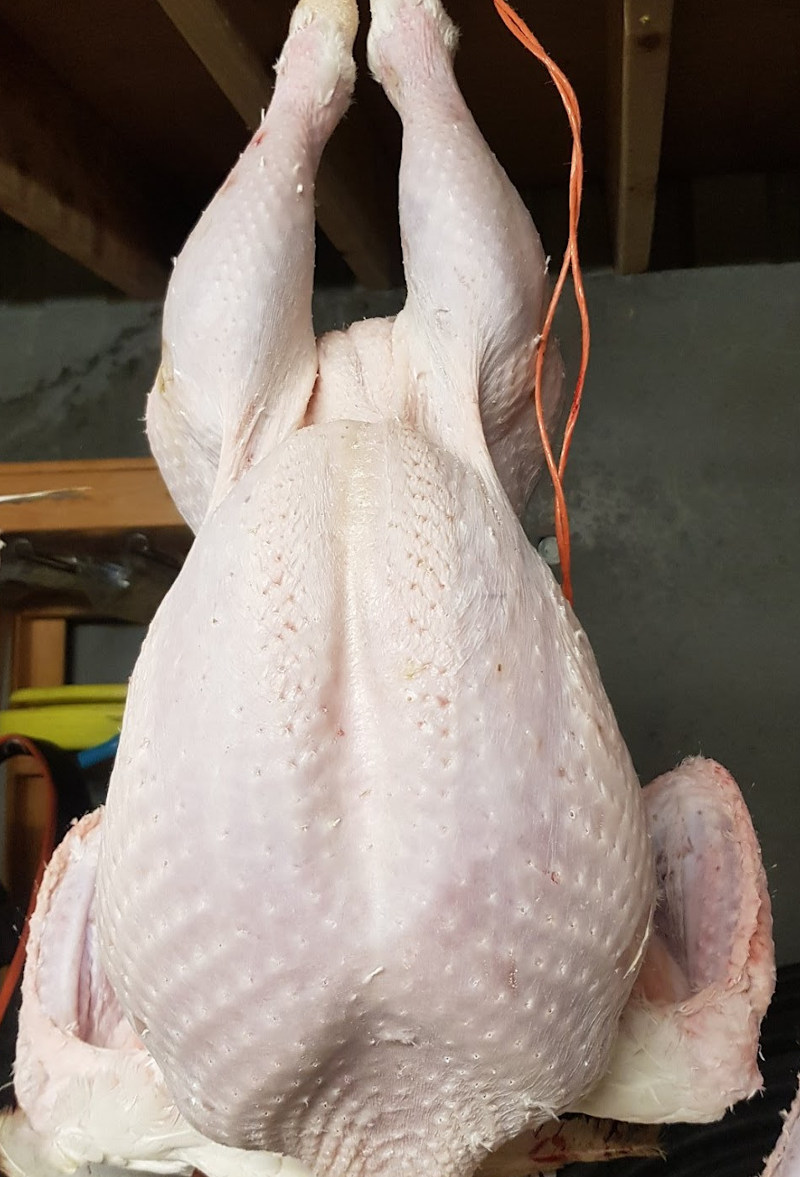Keeping Marans chickens for meat.

As the title suggests this page is about the dual purpose utility qualities for which the Marans was originally developed - so if for any reason you are opposed to the eating of meat in general or chickens in particular please navigate away from this page.
Are Marans chickens good for meat?
Marans are rather well built and sturdy chickens, without being plump. The body is shaped rectangular, is held almost horizontal and is of medium height. The bird reaches a good weight quite fast and cockerels provide a substantial carcass at 6 months old.
Marans are a good meat chicken, they were developed to be dual purpose and produce a good sized carcass as well as nice eggs. They grow at half the rate of commercial broiling chickens so take longer till processing time.
With longer rearing times and a firmer meat texture they are suited to slower cooking.
What does Marans chicken taste like?
The Marans tastes like chicken but with a slightly stronger flavour. Heritage birds raised for meat are more flavoursome and usually need more cooking than store bought broilers.
At what age are Marans ready?
My Marans will usually reach a dressed weight of between 5-6 lbs in 26-30 weeks, and if raised on pasture they are cheap to produce and finish a virtually fat free bird of beautiful texture. You can grow Marans on to 40 weeks for a bigger bird but they begin to get tough as they age.
Home grown birds will normally be allowed some sort of exercise, which will change the texture of the meat and result in slower growth, which means a more flavoursome bird that has a firmer meat texture.
Commercial "roaster chickens" are slaughtered when they are between 6 and 14 weeks old and Marans at this age a small and a bit scrawny.
My personal preference is to allow the surplus male birds to free range and eat a high mixed grain feed. For the last 21 days the birds can be confined to a smaller ark and fed only mash and grains. The reduction in exercise by penning encourages the laying down of intramuscular fat which leads to more tender and flavoursome meat.
Cooking Marans chickens:
If I really need to roast one I would put it in a casserole type pot with a well fitting lid. First filling the cavity of the dressed bird with chopped onions and sage. I use a herb butter under the breast skin.
Put a layer of chopped root vegetables and a little water or stock in the bottom of the casserole dish and bring to the boil on the stove top for 10 to 15 minutes first. Put the lid on the dish and oven cook till almost ready then uncover and turn the temperature way up to brown the skin.
A preferred cooking method for older birds is to put the plucked and dressed bird in a large pot with some vegetables, say onions, and carrots, maybe some chopped celery and a good bunch of any fresh herbs, cover with water and season with salt and pepper.
Bring it up to nearly boiling on the hotplate then transfer to a slow oven for four hours. You end up with a beautifully moist and tender bird and big pot of lovely stock for soup.
Another wonderful way with a good Marans is to cut off the raw breast meat for stir fries and quick cook dishes. Then use legs for coq au vin and other casseroles or curries. The stripped carcass and giblets make excellent stock.
I strain the stock off and off and freeze it down for future use in soups and casseroles.
I will sometimes use full grown cockerels that haven't been selected for breeding for coq au vin, or chicken in red wine. The bird need to be portioned and jointed and allowed to marinate in red wine, shallots and herbs overnight before slow cooking.
